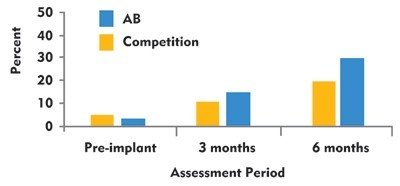
Are Cochlear Implants Right for Your Child?
Advanced Bionics understands that every parent has hopes, expectations and dreams for their child's future. Learning that your baby failed the newborn screening test or discovering that your child is not benefitting from conventional hearing aids can be devastating.
AB offers hope.
AB's state-of-the-art cochlear implant system is designed to help children with severe-to-profound hearing loss learn to listen and talk, attend mainstream schools, and develop lasting friendships with peers.
Children need to hear the words, inflections, and patterns essential for developing strong language skills. An independent study concluded that children with AB devices outperformed children with competitor devices on tests of auditory and oral language skills during the first six months following implantation.1 Many children implanted with AB have the same opportunity for academic success as their normal-hearing peers.
Children begin learning to speak from the day they're born. By the age 3, they need to hear approximately 30,000 words a day to develop the language skills necessary to succeed in school and everyday life. This need to hear language early strongly reinforces the importance of early implantation in children with deafness or hearing loss who would benefit from cochlear implants.2
Without a cochlear implant, "the language gap" between children born deaf or with a hearing loss and their normal-hearing peers can continue to broaden as they mature. The gap may be slightly narrowed or even closed entirely by choosing one or two AB cochlear implants for your child.
“At Claire’s activation, she smiled and laughed. Max frequently gets 100% on his spelling tests, which are administered orally.”
—Stephanie Hawkins, mother of Max, implanted at age 1;
and Claire, implanted at age 1, bilaterally implanted at age 3
Implanted Ears and Aided Ears for Better Hearing
Many children can benefit substantially from using a cochlear implant on one ear and a hearing aid on the other – often referred to as bimodal hearing. Bimodal hearing uses both technologies for optimum performance to help your child reach his or her potential.
Contact your hearing health professional to discuss whether one or both of your ears would benefit more from a cochlear implant than a hearing aid.
Enjoy Surround Sound with Bilateral Hearing
Two ears are always better than one. Many parents choose bilateral cochlear implants for their children with severe-to-profound hearing loss in both ears. Hearing in surround sound helps children localize and enjoy interacting in noisy settings like playgrounds, parks, and birthday parties.
How are Cochlear Implants Different from my Child's Hearing Aids?
Cochlear implants can help provide or restore a rich world of sound for your child. Unlike hearing aids, which simply amplify sound, cochlear implants use state-of-the-art technology to make sound clearer and easier to understand.
For many children with severe-to-profound hearing loss, hearing aids are not enough to compensate for a damaged ear's inability to adequately hear. Cochlear implants bypass the damaged part of your child's inner ear and send sound signals directly to the brain via the hearing nerve. As a result, most AB cochlear implant recipients demonstrate improvement in their ability to understand speech, even in noisy environments, compared to hearing-aid wearers.
Seu filho/sua filha é um candidato ao Implante Coclear?
Faça o nosso teste para crianças (marque todos as opções que se aplicam):
| O seu filho/sua filha atrasou o desenvolvimento da fala e da linguagem, como resultado de sua perda auditiva. | |
| O seu filho/sua filha raramente responde ao seu nome. | |
| Tenho preocupações sobre a capacidade do meu filho/minha filha para ouvir a fala em ambientes ruidosos. | |
| O seu filho/sua filha evita a interação social ou não possui as habilidades necessárias para interagir com outras crianças ou adultos. |
Se você marcou uma ou mais das opções acima, o seu filho/sua filha deve ser um candidato ao Implante Coclear.
References
Bevilacqua et al. Auditory and Language Abilities in Children: Comparison of Two Different Cochlear Implant Systems. Poster Presentation at the 10th International Conference on Cochlear Implant and Other Implantable Auditory Technologies, San Diego, CA April 10-12, 2008.
Hart B, Risley TR. (1995) Meaningful Differences in the Everyday Experience of Young American Children. Brooks Publishing Co, Inc. Baltimore, MD.

